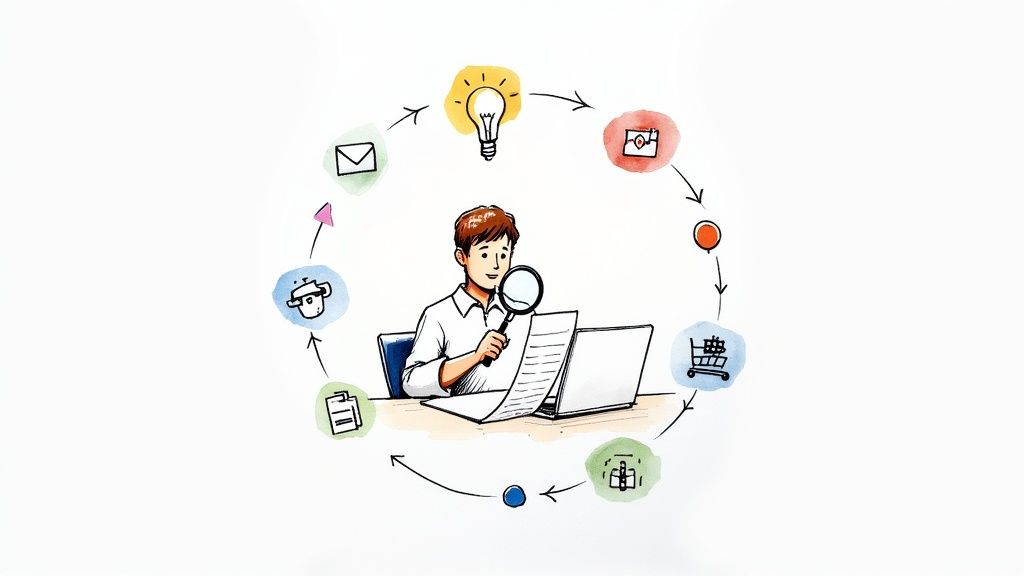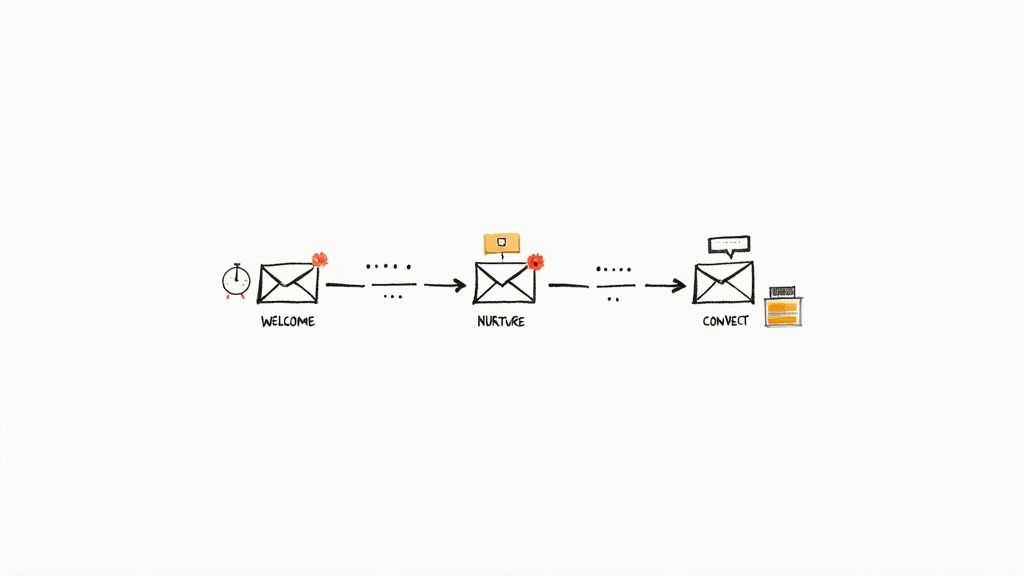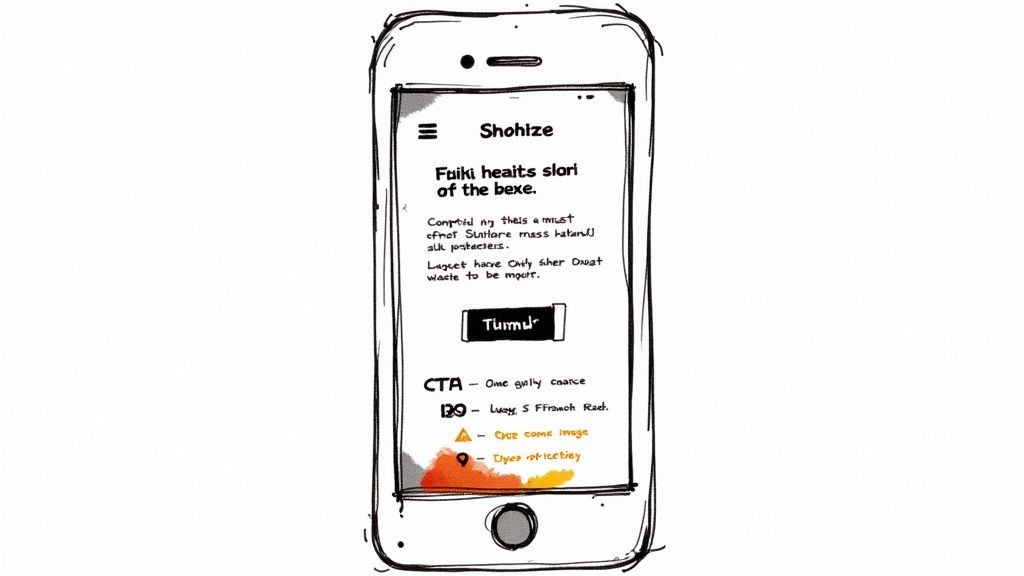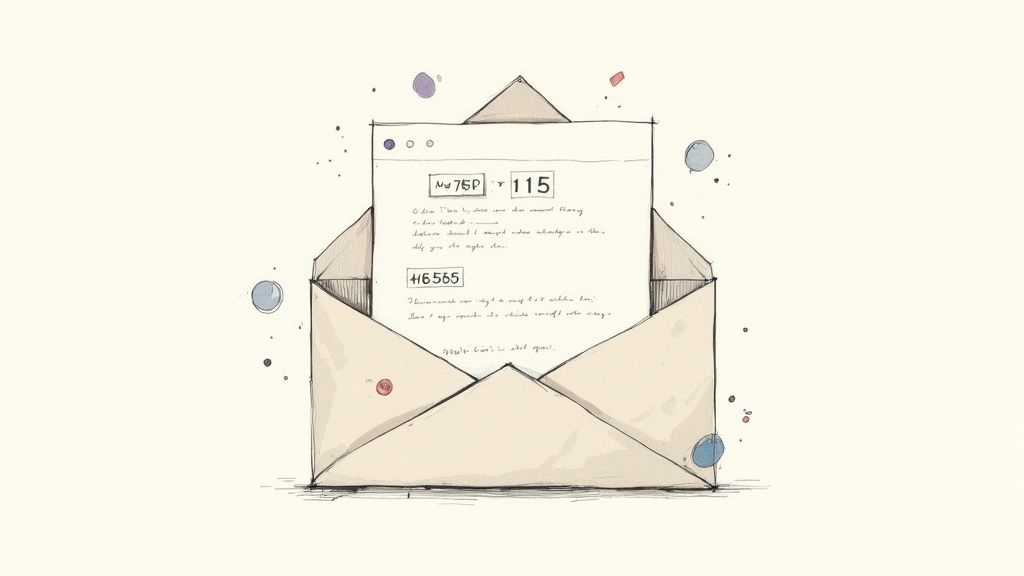
How to Improve Customer Engagement for SMBs
Discover how to improve customer engagement with practical strategies. Learn to personalize experiences, use AI, and build lasting customer loyalty.

Email marketing remains one of the most effective channels for connecting with your audience, delivering an impressive return on investment when executed correctly. Yet, in a landscape of overflowing inboxes and fleeting attention spans, simply sending emails isn't enough. The key to unlocking its full potential lies in deploying strategic, targeted, and value-driven campaigns that resonate with your subscribers on a personal level. Success is no longer measured by the size of your list, but by the quality of your engagement.
This guide moves beyond the basics. We've compiled 10 powerful email marketing campaign strategies essential for any business looking to drive real results. You'll get actionable frameworks and practical insights you can implement immediately. We will explore everything from advanced segmentation and behavioral triggers to the power of automation and A/B testing.
Whether you're a small business owner aiming to nurture new leads, an e-commerce merchant focused on boosting sales, or a marketer looking to refine your approach, this article provides a clear roadmap. Each strategy is broken down into simple, digestible steps to help you build campaigns that not only capture attention but also convert subscribers into loyal advocates for your brand. Let's dive into the tactics that will redefine what you can achieve with your email marketing.
One of the most powerful email marketing campaign strategies is to stop sending generic, one-size-fits-all messages. Segmentation and personalization involve dividing your email list into smaller, targeted groups and tailoring your message specifically for them. This approach treats subscribers as individuals, not just entries in a database.
The core idea is to deliver highly relevant content based on who your subscribers are and how they interact with your brand. Segments can be based on demographics like age and location, behavioral data such as website activity and past purchases, or engagement levels. By sending the right message to the right person at the right time, you dramatically increase the chances of conversion and build stronger customer loyalty.

This strategy moves beyond simple "Hi [First Name]" tactics. Think of Amazon's product recommendations or Netflix suggesting shows based on your viewing history. These companies use sophisticated segmentation to create a personalized experience that feels helpful, not intrusive. The result is higher open rates, increased click-through rates, and a significant boost in sales.
Another essential component of modern email marketing campaign strategies is automation. Automated email sequences, also known as drip campaigns, involve sending a series of pre-written emails to subscribers based on specific triggers or a set schedule. This strategy automates lead nurturing, moving prospects through the sales funnel without constant manual effort.
The goal is to deliver timely, relevant information that guides the user through their customer journey. Whether it's a new subscriber learning about your brand or a customer who just made a purchase, automation ensures they receive the right message at the perfect moment. This creates a consistent and personalized brand experience that builds trust and drives action.

This strategy allows you to engage your audience at scale while maintaining a personal touch. The welcome series you get after signing up or cart abandonment reminders feel helpful and timely because they are triggered by a user's specific action. The result is a highly engaged audience, increased conversions, and more efficient marketing operations.
Your subject line is the gatekeeper to your email content. No matter how brilliant your offer or message is, it won't matter if no one opens it. Subject line optimization is a critical email marketing campaign strategy because it's your first and only chance to make an impression in a crowded inbox. It involves crafting compelling text that entices subscribers to click.
The goal is to stand out and communicate value instantly. A strong subject line sparks curiosity, creates urgency, or offers a clear benefit, compelling the user to see what's inside. Think of it as the headline for your email; its success determines whether the rest of your hard work gets noticed.

An optimized subject line directly impacts your open rates, which in turn affects every other metric. A great subject line, like Sephora’s "Your birthday gift is waiting," feels personal and valuable, while ASOS's "48-hour flash sale: Don't miss up to 70% off" uses urgency and a clear offer to drive immediate action.
Even the most brilliant email marketing campaign strategies will fail without an engaged audience. A list building and lead magnet strategy is the practice of growing a high-quality email list by offering a valuable, free resource (a lead magnet) in exchange for an email address.
This strategy is about a fair value exchange. Instead of just asking for an email, you provide an immediate solution to a specific problem your audience faces. This ensures you attract subscribers who are genuinely interested in what you have to offer, setting the stage for future engagement. Think of it as starting the relationship by giving before you ask.
A strong lead magnet acts as a powerful filter, attracting your ideal customers. When someone downloads your checklist, template, or guide, they are signaling a clear interest in that topic. This provides you with a pre-qualified lead who is more receptive to your future marketing messages, leading to higher open rates and more effective campaigns.
An essential element of any modern email marketing campaign strategy is prioritizing mobile-first design. This approach involves creating emails specifically optimized for viewing on smaller screens. With a majority of users opening emails on mobile devices, ensuring your message is readable and engaging on the go is no longer optional; it's a requirement for success.
The core principle is to design for the smallest screen first and then adapt the layout for larger desktop screens. This ensures a seamless and positive user experience for every subscriber. A clunky, hard-to-read mobile email is often deleted in seconds, wasting your marketing efforts.
Think about your own habits. If an email forces you to pinch and zoom just to read it, you're more likely to abandon it. A mobile-first design eliminates this friction. Companies like Uber excel at this, sending clean, concise updates that are perfectly formatted for a phone screen. This user-centric approach leads to higher engagement and a more professional brand image.
Behavioral trigger email marketing is a highly effective strategy that involves sending automated emails in response to a specific user action. Instead of broadcasting to a schedule, these messages are delivered in real-time, when a customer’s interest is at its peak. This action-based approach ensures your communication is always contextually relevant.
The core principle is to react instantly to user behavior, creating a timely and personalized dialogue. Actions like abandoning a shopping cart, browsing a specific product category, or downloading a resource can all trigger a pre-defined email. This is one of the most powerful email marketing campaign strategies because it capitalizes on the user's current mindset.
This strategy is effective because it’s fundamentally helpful. An abandoned cart email is a useful reminder for a distracted shopper. A post-purchase follow-up with care instructions or related products enhances the customer experience. By responding directly to a user's actions, you provide immediate value, which builds trust and encourages conversion.
One of the most sustainable email marketing campaign strategies is to focus on providing consistent value through content. An email newsletter strategy involves regularly sending educational, entertaining, or insightful content to your subscribers, positioning your brand as a trusted authority.
The core idea is to build a relationship with your audience by giving them something valuable for free. This keeps your brand top of mind and nurtures leads over time. Instead of only reaching out when you want to make a sale, you create an engaged community that looks forward to hearing from you.
This strategy transforms your email list from a marketing channel into a media asset. By consistently delivering valuable content, you earn your subscribers' attention and trust. When it's time to promote a product, your audience is far more receptive because you've already established credibility. This approach generates long-term loyalty.
One of the most essential email marketing campaign strategies is to move from guesswork to a data-driven approach. A/B testing, or split testing, involves creating two or more versions of an email and sending them to different subsets of your audience to see which performs better. This experimentation allows you to systematically improve your campaigns based on real user behavior.
The core idea is to test one variable at a time, such as the subject line, call-to-action (CTA) button color, or send time. By isolating a single element, you can confidently attribute any difference in performance to that specific change. This continuous cycle of testing, learning, and optimizing ensures your email marketing becomes more effective over time.
This strategy eliminates subjective debates and replaces them with hard data. For instance, instead of arguing about whether a playful or a direct subject line is better, you can test both and let your audience decide. This methodical approach leads to incremental gains that compound into significant performance improvements.
While many marketing efforts focus on attracting new leads, one of the most profitable email marketing campaign strategies is to nurture the customers you already have. Customer retention and loyalty campaigns are emails designed to encourage repeat business, build brand affinity, and turn one-time buyers into lifelong advocates. Retaining an existing customer is significantly more cost-effective than acquiring a new one.
The core idea is to make existing customers feel valued and give them compelling reasons to stay engaged. These campaigns go beyond simple transaction confirmations and deliver exclusive value. By recognizing their loyalty with special offers, early access, or milestone rewards, you strengthen the customer relationship.
This strategy capitalizes on existing trust. A customer who has already purchased from you is far more likely to buy again than a cold lead. Think of the Starbucks Rewards program, which uses emails to notify members of special promotions, making customers feel like insiders and fostering a sense of community.
One of the most forward-thinking email marketing campaign strategies is to move beyond static text and images. Interactive and dynamic content transforms a passive reading experience into an active one by embedding elements users can engage with directly inside their inbox, using technologies like AMP for Email.
The goal is to reduce friction and capture user action at the moment of peak interest. Instead of clicking a link to visit a website to fill out a survey or browse a product gallery, subscribers can do it all without ever leaving their email. This creates a seamless, app-like experience that boosts engagement.
This strategy grabs attention and makes it incredibly easy for subscribers to take the next step. By removing the need to open a new tab, you eliminate a major drop-off point in the customer journey. Interactive elements, such as carousels or add-to-cart buttons, lead to dramatically higher user participation.
The journey through these ten email marketing campaign strategies reveals a powerful truth: the inbox is no longer a simple broadcast channel. It has evolved into an arena for building genuine customer relationships at scale. Success in today's crowded digital landscape hinges on a strategy that is intelligent, responsive, and human-centric.
We’ve covered a wide array of tactics, from the necessity of segmentation to the potential of interactive content. Each strategy serves as a critical component in a larger marketing machine. The true art lies in knowing which tool to use, when to use it, and how to combine them for maximum impact.
Progress begins with a single, deliberate step. Instead of attempting a complete overhaul overnight, focus on incremental improvements.
Ultimately, the most effective email marketing campaign strategies are built on a foundation of empathy and value. Every email should answer the subscriber's question: "What's in it for me?" Executing these strategies requires not just a clear plan but also the right technology. Investing in the top email outreach tools can help automate segmentation, streamline testing, and provide the analytics necessary to refine your approach.
By embracing this new paradigm, you transform your email list from a static database into a vibrant community of engaged customers and brand advocates. The reward isn't just higher open rates; it's sustainable growth driven by stronger, more profitable customer relationships.
Ready to implement these powerful email marketing campaign strategies but need an expert partner to guarantee results? BrandBooster.ai combines advanced AI with human marketing expertise to create outcome-driven campaigns that deliver a guaranteed return on your investment. Stop guessing and start growing by visiting us at BrandBooster.ai to learn more.